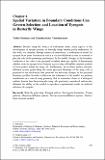Spatial variation in boundary conditions can govern selection and location of eyespots in butterfly wings
Abstract
Despite being the subject of widespread study, many aspects of the development of eyespot patterns in butterfly wings remain poorly understood. In this work, we examine, through numerical simulations, a mathematical model for eyespot focus point formation in which a reaction-diffusion system is assumed to play the role of the patterning mechanism. In the model, changes in the boundary conditions at the veins at the proximal boundary alone are capable of determining whether or not an eyespot focus forms in a given wing cell and the eventual position of focus points within the wing cell. Furthermore, an auxiliary surface reaction diffusion system posed along the entire proximal boundary of the wing cells is proposed as the mechanism that generates the necessary changes in the proximal boundary profiles. In order to illustrate the robustness of the model, we perform simulations on a curved wing geometry that is somewhat closer to a biological realistic domain than the rectangular wing cells previously considered, and we also illustrate the ability of the model to reproduce experimental results on artificial selection of eyespots.
Citation
Venkataraman , C & Sekimura , T 2017 , Spatial variation in boundary conditions can govern selection and location of eyespots in butterfly wings . in T Sekimura & F H Nijhout (eds) , Diversity and Evolution of Butterfly Wing Patterns . 1 edn , 6 , Springer , Singapore , pp. 107-118 . https://doi.org/10.1007/978-981-10-4956-9_6
Publication
Diversity and Evolution of Butterfly Wing Patterns
Type
Book item
Rights
© The Author(s) 2017. This chapter is licensed under the terms of the Creative Commons Attribution 4.0 International License (http://creativecommons.org/licenses/by/4.0/), which permits use, sharing, adaptation, distribution and reproduction in any medium or format, as long as you give appropriate credit to the original author(s) and the source, provide a link to the Creative Commons license and indicate if changes were made. The images or other third party material in this chapter are included in the chapter’s Creative Commons license, unless indicated otherwise in a credit line to the material. If material is not included in the chapter’s Creative Commons license and your intended use is not permitted by statutory regulation or exceeds the permitted use, you will need to obtain permission directly from the copyright holder.
Items in the St Andrews Research Repository are protected by copyright, with all rights reserved, unless otherwise indicated.

